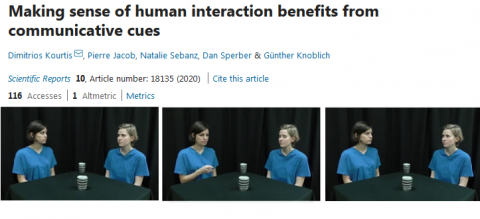
Dimitrios Kourtis, Pierre Jacob, Natalie Sebanz, Dan Sperber & Günther Knoblich
We investigated whether communicative cues help observers to make sense of human interaction. We recorded EEG from an observer monitoring two individuals who were occasionally communicating with each other via either mutual eye contact and/or pointing gestures, and then jointly attending to the same object or attending to different objects that were placed on a table in front of them. The analyses were focussed on the processing of the interaction outcome (i.e. presence or absence of joint attention) and showed that its interpretation is a two-stage process, as reflected in the N300 and the N400 potentials. The N300 amplitude was reduced when the two individuals shared their focus of attention, which indicates the operation of a cognitive process that involves the relatively fast identification and evaluation of actor–object relationships. On the other hand, the N400 was insensitive to the sharing or distribution of the two individuals’ attentional focus. Interestingly, the N400 was reduced when the interaction outcome was preceded either by mutual eye contact or by a perceived pointing gesture. This shows that observation of communication “opens up” the mind to a wider range of action possibilities and thereby helps to interpret unusual outcomes of social interactions.